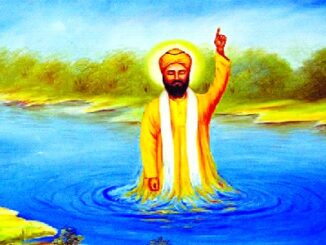
Sant Kabir Das (1440-1518 circa) was a famous poet, saint and social reformer of India. His writings have greatly influenced the Bhakti movement. Kabir Panth which is a religious community recognizes him as its founder and its members are known as Kabir Panthis, the followers of Saint Kabirdas.
His writings include Bijak, Sakhi Granth, Kabir Granthawali and Anurag Sagar. The major part of Kabir’s work was collected by the fifth Sikh Guru, Guru Arjan Dev, and incorporated into the Sikh scripture Guru Granth Sahib. The hallmark of Kabir’s work consists of his two line couplets, known as Kabir Ke Dohe.
About Kabir Das
Sant Kabir Das was born in the city of Varanasi, Uttar Pradesh. He was brought up by a Muslim couple who were weavers by profession.
He was a renowned saint, poet and social reformer of India who lived during the 15th century. His esteemed works and poems describe the greatness and oneness of the Supreme Being. Sant Kabir Das was a proponent of Bhakti Movement.
The legacy of Kabir Das still remains through a sect referred to as Panth of Kabir, a spiritual community that considers him as the founder. Kabir Panth is not a separate religion, but a spiritual philosophy.
In his poems, Kabir calls himself a julaha and kori. Both mean weaver, belonging to a lower caste. He did not associate himself completely with either Hindus or Muslims.
Kabir did not undertake any formal education. He was not even trained as a weaver. While his poems abound with weaving metaphors, his heart was not fully into this profession. He was on a spiritual journey to seek the truth, which is clearly manifested in his poetry.
Sant Kabir Das’ early life was in a Muslim family. He was brought up by a family of Muslim julahas or weavers, but he was strongly influenced by Vaishnava Saint Swami Ramananda (his teacher), the Hindu bhakti leader.
Some of his famous writings include ‘Sakhi Granth’, ‘Anurag Sagar’, ‘Bijak’ and ‘Kabir Granthawali’. His great writing, Bijak, has a huge collection of poems.
The writings of Kabir Das were mainly based on the concept of reincarnation and karma.
After being an illiterate he had written his poems in Hindi mixing with Avadhi, Braj, and Bhojpuri. The poems are called variously as ‘Dohe’, ‘Saloka’ and ‘Sakhi’.
Sant Kabir Das was best known for his two-line couplets, referred to as ‘Kabir Ke Dohe‘.
The major part of his work was collected by the fifth Sikh guru, Guru Arjan Dev.
The verses of Kabir Das are found in Sikhism’s scripture Guru Granth Sahib.
Kabir’s works were mainly written in the Hindi language.
In the 15th century, when Persian and Sanskrit were predominant North Indian languages, he chose to write in colloquial, regional language.
His poetry is a mixture of Hindi, Khari Boli, Punjabi, Bhojpuri, Urdu, Persian and Marwari.
Contribution of Sant Kabir Das to Bhakti Movement
Sant Kabir Das got fame all over the world because of his influential traditions and culture. He was prejudiced by the existing religious mood of that time like Hinduism, Tantrism as well as personal devotionalism.
Kabir Das tried to coordinate the religions by giving a universal path which could be followed by all human beings. According to him, every life has a relationship with two spiritual principles (Jivatma and Paramatma). His view about the moksha is that it is the process of uniting these two divine principles.
He simply followed the oneness of God. In the Dabistan of Mohsin Fani and Ain-i-Akbari of Abul Fazl, he is mentioned as a ‘Muwahid’ (Believer in one God).
He always opposed the idea of worshipping the idols and showed clear confidence in Bhakti and Sufi ideas.
He composed poems in a concise and simple style, resonating the admiration for the factual guru.
He tried to interpret the meaning of the true religion of human beings that one should follow. This has helped the common people to understand his message very easily. He was against the caste system imposed by the Hindu community. Not just caste, Kabir also criticised the rites, rituals and customs which he thought were futile. From Khajinat al-Asafiya, we find that a Sufi Pir, Shaikh Taqqi was also the teacher of Kabir. Sufi-influence is also quite apparent in Kabir’s teaching and philosophy.
Sant Kabir’s teachings revolved around the concept of the formless God and rejected the traditional beliefs and rituals of both Hinduism and Islam. Kabir emphasized the importance of devotion, love, and meditation to attain spiritual enlightenment. He believed that every human has a spark of the divine and should strive to connect with it. He particularly criticized the caste system, social inequality, and emphasized the equality of all humans. Sant Kabir’s works have inspired millions of people to seek spiritual enlightenment and a connection with the divine.
Sant Kabir’s works include verses, couplets, and hymns that reflect his teachings and ideas. He wrote in Hindi and drew inspiration from both Hindu and Muslim traditions. One of his most popular works is the “Bijak,” a compilation of couplets that reflect his philosophy. His works were simple yet profound and inspire people to this day.
Sant Kabir’s teachings embody the spirit of love, devotion, and universal brotherhood. His philosophy transcended the boundaries of castes, religion, and nationality and aimed to connect all humans with the divine. The influence of his teachings can be found in several Indian religions, including Sikhism and Hinduism. His influence is widely felt in the field of literature, music, and spirituality.





Be the first to comment